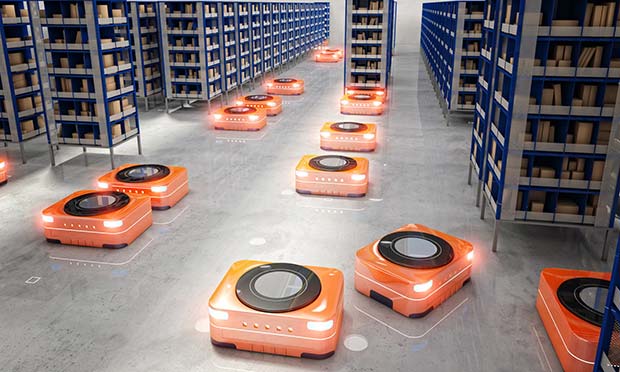Yanis Lounnas, Applications Engineer at EnerSys®, summarises the advantages of AGVs and explains the role of batteries in fulfilling their potential.
 As warehouses move towards full automation, automated guided vehicles (AGVs) are taking materials handling beyond fixed machinery and enabling free movement through sites. Unlike static installations, most AGVs are not wired to the mains electricity supply but rely on motive batteries for power.
As warehouses move towards full automation, automated guided vehicles (AGVs) are taking materials handling beyond fixed machinery and enabling free movement through sites. Unlike static installations, most AGVs are not wired to the mains electricity supply but rely on motive batteries for power.
AGV benefits
An AGV is a type of mobile robot. Within warehouses and factories, they can replace lift trucks in transporting, storing and retrieving goods.
AGVs can be designed with smaller dimensions than conventional lift trucks, enabling higher storage density. Automation lowers the risk of errors and product damage, as well as the need for lighting and heating. AGVs can take on tasks that are uncomfortable or dangerous for workers. They also make the workplace safer, thanks to their precisely controlled movements and inbuilt safety systems. On sensing human presence, they are built to sound an alarm, slow down and, if necessary, stop.
AGV categories
The simplest AGVs are just automated carts into which goods are placed for transport. Tugger AGVs, in which a powered unit pulls a trailer, or a train of trailers, are an advance on this.
A unit load or ‘top carrier’ AGV typically carries an item on its deck. The larger ones will transport heavy goods like engines, paper rolls and steel coils. Smaller designs include thin, box-shaped robots.
Meanwhile, forklift AGVs are designed to replace manned warehouse lift trucks – picking orders, stacking and reaching, among other tasks.
Navigation and control
AGV activities are directed by software and sensor-based systems. The earliest AGVs followed a path set by inductive wires embedded in the floor, which makes layout modification difficult. Magnetic strips, bars or dots on the floor are more flexible, and laser scanning of reflectors placed throughout the warehouse is a versatile alternative. A further option is inertial guidance, using a computer and sensors to calculate position. There is also GPS navigation.
While these technologies enable AGVs to be programmed to carry out repetitive tasks, artificial intelligence promises to make them more autonomous. Some advanced AGVs can now explore new environments, create their own maps and calculate ideal routes.
AGVs that can learn and make decisions give us a glimpse of Industry 4.0. The Internet of Things is used extensively in controlling and monitoring AGVs. Through wireless communication, data is collected from the AGVs and instructions are transmitted.
Battery choices
To maintain AGV productivity and efficiency, one aim is to minimise time and effort spent on maintaining and charging their batteries. Traditional flooded lead-acid batteries have the highest maintenance needs.
However, this is the least expensive battery type, and in some cases, it may be the right choice despite its maintenance demands.
Sealed lead-acid batteries, including gel and absorbent glass mat (AGM) types, although maintenance-free, typically require a full recharge after every shift, which takes several hours. However, advanced AGM batteries based on Thin Plate Pure Lead (TPPL) technology – like lithium-ion batteries – can be opportunity-charged during short breaks. With increasing energy demand, lithium-ion batteries can offer a more viable solution thanks to their higher energy density and ultra-fast charge capabilities. Their downside is their high price, but this may reduce in future.
In all cases, batteries must be specified with enough capacity to prevent runouts during shifts. Ultimately, battery choice depends on the accurate calculation of total cost of ownership (TCO) and return on investment (ROI) for each option.
Charging and power management
For some operations and working patterns with little stoppage time, opportunity charging is not enough to meet an AGV’s power demands. Replacing discharged batteries with fully charged packs may be the best option.
Another effective way to run the AGVs, when time is available between tasks, is with fast opportunity charging. Chargers are installed at points on the AGV’s path to provide replenishment during short breaks. The process can be automated, with AGVs seeking a charging station whenever charge drops below a certain level.
Increases in digitisation, collection and exchange of data have been essential to the development of automated warehouses. When fitted with sensors and communication electronics, AGVs are useful as data-gathering and transmitting devices, and can even act on received data. These functions are a good basis for fleet management systems.
Ideally, all data from AGVs, chargers and battery handling devices should be drawn together by a single integrated platform for analysis and production of actionable outputs. The EnerSys® Xinx™ battery operations management system, connected wirelessly to EnerSys® Wi-iQ® battery-mounted monitoring devices, is a good example.
AGV batteries, charging equipment and power management technology should be supplied as a complete service by a specialist who can assess the ideal combination for each application. To find out more, visit www.enersys.com.




Comments are closed.